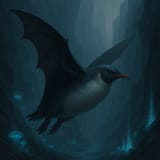Search Results
7/19/2025, 6:54:29 PM
Lmao
Aerodyptes vespertilio - “bat-wing dusk penguin”
Earth’s surface is fragmented and unstable. Ocean levels have risen and fallen hundreds of times. The sun is brighter, but the atmosphere is thinner, and the magnetic field has weakened - exposing life to extreme radiation and ion storms. True birds are mostly extinct, but a few descendants endure in alien niches. Among them: the dusk penguins.
Aerodyptes vespertilio is a flying, cave-dwelling penguin species that re-evolved powered flight in the perpetual twilight of Earth’s shadow hemisphere. Once exclusively aquatic, these penguins adapted to survive in deep atmospheric canyons where heat, shelter, and prey converge.
Wings are now leathery and bat-like - derived from fused feather filaments hardened into flexible membranes. Their flight is silent, gliding through sulfurous thermals in bio-luminescent rift valleys. Unlike any modern bird, Aerodyptes echolocates with pulsed trills from its syrinx, navigating pitch-black canopies of fungal towers and gas vents.
Their bodies are coated in reflective down to shield against cosmic rays. The beak has evolved into a hooked, infrared-sensitive organ, used to pluck thermal plankton from geothermal bloom clouds. Eyes are reduced, but their lateral line system - once primitive - is now hyper-sensitive to air currents and electromagnetic shifts.
They nest upside-down in insulated vaults carved into canyon walls. Eggs are gelatinous, semi-buoyant, and incubated in hanging mucus sacs. Colonies operate like loosely coordinated bat rookeries - vocal, mobile, and territorially aggressive.
Aerodyptes is not warm-blooded in the traditional sense. It “ram charges” internal heat through sustained wingbeats, and shuts down nonessential systems during cold cycles - a flying ember in a dying sky.
Aerodyptes vespertilio - “bat-wing dusk penguin”
Earth’s surface is fragmented and unstable. Ocean levels have risen and fallen hundreds of times. The sun is brighter, but the atmosphere is thinner, and the magnetic field has weakened - exposing life to extreme radiation and ion storms. True birds are mostly extinct, but a few descendants endure in alien niches. Among them: the dusk penguins.
Aerodyptes vespertilio is a flying, cave-dwelling penguin species that re-evolved powered flight in the perpetual twilight of Earth’s shadow hemisphere. Once exclusively aquatic, these penguins adapted to survive in deep atmospheric canyons where heat, shelter, and prey converge.
Wings are now leathery and bat-like - derived from fused feather filaments hardened into flexible membranes. Their flight is silent, gliding through sulfurous thermals in bio-luminescent rift valleys. Unlike any modern bird, Aerodyptes echolocates with pulsed trills from its syrinx, navigating pitch-black canopies of fungal towers and gas vents.
Their bodies are coated in reflective down to shield against cosmic rays. The beak has evolved into a hooked, infrared-sensitive organ, used to pluck thermal plankton from geothermal bloom clouds. Eyes are reduced, but their lateral line system - once primitive - is now hyper-sensitive to air currents and electromagnetic shifts.
They nest upside-down in insulated vaults carved into canyon walls. Eggs are gelatinous, semi-buoyant, and incubated in hanging mucus sacs. Colonies operate like loosely coordinated bat rookeries - vocal, mobile, and territorially aggressive.
Aerodyptes is not warm-blooded in the traditional sense. It “ram charges” internal heat through sustained wingbeats, and shuts down nonessential systems during cold cycles - a flying ember in a dying sky.
Page 1
